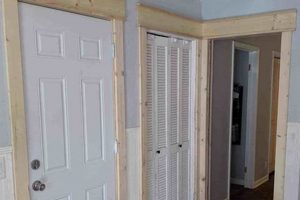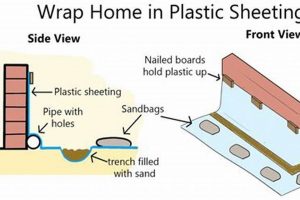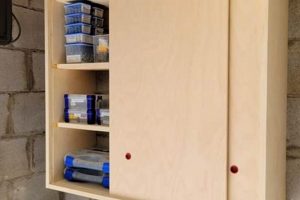The construction of a custom entryway using lumber and personal labor represents a common approach to home improvement. This method allows homeowners to tailor the dimensions, design, and materials of a portal to specific needs and aesthetic preferences. An example would be building a plank-style passage for a shed or crafting a paneled entry for a residential space.
Creating a bespoke portal offers several advantages, including cost savings compared to purchasing pre-made options and the opportunity to increase property value through personalized design. Historically, self-made portals were commonplace, reflecting reliance on available resources and individual craftsmanship. This tradition continues today, driven by both practical necessity and a desire for unique architectural elements.
The subsequent discussion will cover essential aspects of design and construction, material selection considerations, necessary tools and equipment, step-by-step building instructions, finishing techniques, and essential safety precautions to ensure a successful project.
Essential Considerations for Self-Constructed Wooden Entryways
The following guidelines provide crucial insights into the creation of durable and aesthetically pleasing self-constructed wooden entryways, emphasizing meticulous planning and execution.
Tip 1: Material Selection is Paramount: Prioritize the selection of lumber appropriate for the intended environment. Exterior applications demand naturally rot-resistant species or pressure-treated wood to mitigate degradation from moisture and insects.
Tip 2: Precise Measurements are Critical: Obtain accurate measurements of the opening to ensure a snug, functional fit. Deviations can lead to operational difficulties and compromised structural integrity.
Tip 3: Prioritize Squareness and Alignment: Maintaining squareness throughout the frame construction process is essential for proper hanging and functionality. Employ framing squares and levels to verify alignment at each stage.
Tip 4: Implement Robust Joinery Techniques: Utilize strong joinery methods, such as mortise-and-tenon or reinforced butt joints, to guarantee structural stability and longevity, particularly in load-bearing areas.
Tip 5: Thoroughly Sand All Surfaces: Before applying any finish, meticulously sand all surfaces to create a smooth, even substrate. This enhances the adhesion and appearance of the chosen finish.
Tip 6: Apply a High-Quality Finish: Protect the wood with a durable finish appropriate for the intended exposure. Exterior installations require weather-resistant sealants, stains, or paints to prevent moisture absorption and UV damage.
Tip 7: Hardware Selection and Installation: Choose hardware suitable for the size and weight of the portal. Securely attach hinges, handles, and locking mechanisms to ensure proper operation and security.
By adhering to these recommendations, individuals can successfully construct robust and visually appealing entryways. Careful consideration of materials, precise execution, and protective finishing techniques are crucial for ensuring structural integrity and extending the lifespan of a self-constructed wooden entryway.
The subsequent section will delve into strategies for troubleshooting common issues encountered during the construction process.
1. Material Durability
The longevity and performance of a self-constructed wooden passage are directly contingent upon the inherent durability of the selected material. Material properties, such as resistance to moisture, insect infestation, and physical stress, dictate the portal’s ability to withstand environmental exposure and operational wear. Failure to consider material durability can result in premature deterioration, structural instability, and costly repairs. For example, a pine entryway installed without proper treatment in a humid climate will be susceptible to rot and fungal growth, ultimately compromising its integrity.
The choice of wood species significantly impacts durability. Hardwoods like oak and maple offer greater resistance to impact and abrasion compared to softwoods such as pine or cedar. Furthermore, treatment methods such as pressure treating or the application of preservatives enhance the material’s resistance to decay and insect damage. The use of reclaimed wood, while aesthetically appealing, requires careful inspection and treatment to ensure it is free from existing infestations or structural weaknesses. Selecting appropriate fastening hardware that resists corrosion is also essential for maintaining the structural integrity of the construction over time.
In summary, material durability is a critical determinant of the lifespan and functionality of a self-made wooden access point. Careful selection of wood species, application of appropriate treatments, and consideration of environmental factors are essential for ensuring a robust and enduring result. Ignoring these considerations can lead to significant long-term consequences, undermining the value and utility of the construction. The interaction between wood selection, proper treatment and the overall design and environmental factors, is necessary to a functional and long lasting barrier.
2. Frame Construction
Frame construction forms the foundational element of any wooden portal intended for self-assembly. It is the skeletal structure that dictates the portal’s overall dimensions, shape, and structural integrity. Accurate and robust frame construction directly impacts the performance, longevity, and operational effectiveness of the completed unit. An improperly constructed frame can lead to issues such as sagging, warping, misalignment, and difficulty in operation, rendering the entire project functionally deficient. For example, a frame not built perfectly square will be difficult to hang and may not seal properly, allowing drafts and compromising security.
The specific techniques employed in frame construction, such as the selection of joinery methods (e.g., mortise and tenon, rabbet joints, or butt joints reinforced with screws or dowels) and the alignment of structural members, are critical. The choice of materials for the frame, typically lumber, must also be carefully considered. Factors such as wood species, moisture content, and dimensional stability influence the frame’s resistance to warping, shrinking, or swelling. Furthermore, the integration of internal support structures, such as cross-bracing or solid-core infill, enhances the frame’s resistance to deformation under stress. A solid wood frame crafted for external usage should consider a water proof adhesive to ensure its longetivity.
In conclusion, frame construction represents a critical process in the successful execution of a wooden barrier. A well-constructed frame serves as the essential foundation upon which the entire structure depends. Precise measurements, the implementation of robust joinery techniques, and the selection of appropriate materials are paramount to ensuring the stability, durability, and functionality of the final product. Neglecting these considerations can lead to a cascade of problems, ultimately undermining the value and practicality of the endeavor.
3. Hanging Hardware
The successful installation and operation of a self-constructed wooden portal are intrinsically linked to the proper selection and application of hanging hardware. These components are not merely ancillary; they are integral to the functionality, security, and longevity of the access point.
- Hinge Selection and Load Capacity
The selection of hinges must align with the weight and dimensions of the portal. Under-specified hinges can lead to sagging, binding, and premature failure, compromising the structural integrity of the installation. For instance, a heavy solid wood entryway requires heavy-duty hinges with a sufficient load-bearing capacity, such as ball-bearing hinges or strap hinges.
- Attachment Methods and Fastener Selection
The method of attaching the hardware to both the entryway and the frame is crucial. Screws, bolts, and other fasteners must be appropriately sized and constructed from materials compatible with the wood species to prevent corrosion or loosening over time. Pilot holes are essential to prevent wood splitting during installation. Improper attachment can lead to hardware detachment, rendering the entryway inoperable.
- Alignment and Adjustment Mechanisms
Precise alignment of the entryway within the frame is necessary for smooth operation and a proper seal. Adjustable hinges or shims may be required to compensate for minor imperfections in the frame or entryway construction. Misalignment can cause friction, difficulty in locking, and air infiltration, negatively impacting energy efficiency.
- Security Hardware and Strike Plate Installation
The inclusion of robust locking mechanisms and properly installed strike plates contributes significantly to the security of the structure. Reinforcement of the strike plate area with metal backing plates or longer screws increases resistance to forced entry. A weak or improperly aligned strike plate compromises the effectiveness of the locking mechanism.
The choice of hanging hardware extends beyond mere aesthetics; it encompasses a functional imperative. Proper selection, installation, and maintenance of these components are essential for ensuring the smooth operation, structural integrity, and security of a self-constructed wooden portal. Neglecting these considerations can negate the effort invested in the construction process, leading to operational difficulties and security vulnerabilities.
4. Surface Finishing
Surface finishing is an indispensable step in the construction of a wooden entryway, serving both aesthetic and protective functions. Its proper execution is critical for maximizing the lifespan and visual appeal of the final product.
- Protection Against Environmental Elements
Surface finishes act as a barrier against moisture, ultraviolet radiation, and temperature fluctuations, all of which can cause warping, cracking, and decay in wood. Exterior applications necessitate weather-resistant finishes such as marine-grade varnishes or paints, while interior entries may utilize stains, sealers, or polyurethanes for enhanced durability. For example, a door exposed to direct sunlight without UV protection will experience accelerated degradation.
- Enhancement of Aesthetic Qualities
Finishes can highlight the natural grain and color of the wood, or alternatively, alter its appearance entirely through the application of opaque paints or stains. The selection of finish directly influences the overall style and visual impact of the entryway, allowing for customization to complement architectural aesthetics. An entryway finished with a clear coat will showcase the woods natural beauty, whereas a painted entryway can introduce a pop of color or seamlessly blend with the surrounding decor.
- Durability and Ease of Maintenance
Surface finishes provide a protective layer that resists scratches, scuffs, and stains, extending the lifespan of the construction and simplifying maintenance. Durable finishes, such as polyurethane, can withstand frequent cleaning and exposure to abrasive materials. Regularly maintaining the finish will prevent damage and preserve the appearance of the door for an extended period.
- Adhesion and Application Techniques
The success of any surface finishing application hinges on proper surface preparation, including sanding, cleaning, and priming. Adhesion issues can arise from inadequate preparation, resulting in peeling, blistering, or cracking of the finish. Applying multiple thin coats, rather than one thick coat, typically yields a more durable and aesthetically pleasing result. Proper ventilation during the application process is also crucial, particularly when using solvent-based finishes.
The integration of appropriate surface finishing techniques directly contributes to the longevity, visual appeal, and overall value of a self-constructed wooden entryway. By carefully considering the environmental factors, aesthetic preferences, and application methods, individuals can ensure a durable and visually appealing result. Neglecting these aspects can lead to premature deterioration, detracting from the overall quality of the construction.
5. Design Aesthetic
The visual characteristics of a self-constructed wooden portal are determined by the choices made in design. These choices are integral to the entryway’s integration with the surrounding architectural style and its reflection of individual preferences.
- Architectural Harmony
The design should complement the existing architectural style of the building. A rustic plank-style entry may suit a farmhouse, while a paneled entry with clean lines is more appropriate for a modern residence. Incongruent styles can detract from the overall visual appeal and perceived value of the property. For instance, installing a Victorian-era style entry on a contemporary-designed house would clash.
- Material Selection and Finish
The type of wood and its subsequent finish significantly influence the aesthetic. Reclaimed wood offers a rustic, weathered appearance, while hardwoods like walnut or cherry convey elegance and formality. The choice between a natural finish, stain, or paint impacts the perceived texture and color of the entryway. A naturally finished oak entryway could project a sense of warmth, whereas a high-gloss black paint could give a modern feel.
- Hardware and Detailing
The selection of hardware, such as handles, hinges, and strike plates, contributes to the overall aesthetic. Simple, minimalist hardware complements a modern design, while ornate, antique-style hardware suits a more traditional style. The inclusion of decorative elements, such as carvings, moldings, or glass inserts, further enhances the design. For example, using brushed nickel hardware on a door painted in a neutral color.
- Proportion and Scale
The size and proportions of the entryway must be appropriate for the opening and the overall scale of the building. An entry that is too small can appear insignificant, while an entry that is too large can overwhelm the faade. Paying attention to the relationship between the entryway, its frame, and the surrounding walls is crucial for achieving a balanced and visually pleasing result. An over-sized and unnecessarily large barrier is a common mistake to avoid.
These elements, when harmoniously integrated, contribute to an entryway that enhances the aesthetic value of the building and reflects the homeowner’s individual style. Consideration of these design principles ensures that the structure is not merely functional but also a visually appealing addition to the property.
Frequently Asked Questions
The following questions address common inquiries and misconceptions regarding the design, construction, and installation of wooden access points. These responses aim to provide clarity and guidance for individuals undertaking such projects.
Question 1: What wood species are best suited for exterior self-constructed wooden portals?
Naturally rot-resistant species such as redwood, cedar, or cypress are recommended for exterior applications. Alternatively, pressure-treated lumber offers protection against decay and insect infestation. The selection should consider the local climate and potential exposure to moisture.
Question 2: How is warping in a self-constructed wooden portal best prevented?
Employing kiln-dried lumber with a low moisture content is crucial. Proper sealing and finishing of all surfaces, including edges and ends, minimizes moisture absorption. Robust frame construction techniques, such as mortise-and-tenon joinery, provide structural stability.
Question 3: What are the essential tools required for self-constructing a wooden access point?
Essential tools include a circular saw, miter saw, drill/driver, measuring tape, framing square, level, sander, and appropriate safety equipment. Specialized tools, such as a router or planer, may be necessary depending on the complexity of the design.
Question 4: How is a perfectly square frame ensured during construction?
Utilizing a framing square to check each corner is paramount. Measuring the diagonals of the frame; equal measurements indicate squareness. Clamps and temporary bracing can maintain squareness during assembly.
Question 5: What type of finish is recommended for maximum weather protection on a self-constructed wooden portal?
Marine-grade varnish or exterior-grade paint provides the most durable protection against moisture, UV radiation, and temperature fluctuations. Multiple coats are typically required for optimal performance. Regular inspection and reapplication are necessary to maintain protection.
Question 6: How can security be enhanced in a self-constructed wooden access point?
Employing a solid-core construction provides increased resistance to forced entry. Installing a high-quality deadbolt lock with a reinforced strike plate and using long screws that penetrate into the frame studs enhance security. Consider adding a peephole for visual verification before opening.
In summary, the success of a wooden barrier construction project hinges on careful material selection, precise execution, and the application of appropriate protective measures. Adhering to established construction principles and prioritizing safety are essential for achieving a durable, functional, and secure result.
The subsequent section will address potential challenges encountered during the construction and installation process, offering practical solutions for overcoming common obstacles.
Conclusion
The foregoing analysis has elucidated the multifaceted aspects inherent in the fabrication of a “diy wood door”. It has underscored the crucial considerations related to material selection, structural integrity, design aesthetics, and functional hardware. Adherence to these principles is paramount for achieving a durable, secure, and visually appropriate entry point.
The self-directed construction of a wooden portal represents a significant undertaking, demanding meticulous planning, skilled execution, and a commitment to quality craftsmanship. While the endeavor presents challenges, the potential for cost savings, customization, and the satisfaction of creating a unique architectural element warrants careful consideration for those with the requisite skills and resources. Further research into specific joinery techniques, finishing methods, and local building codes is strongly advised prior to commencing any such project.







